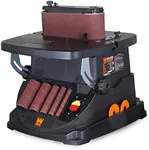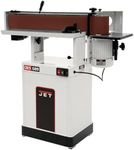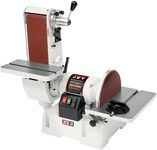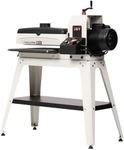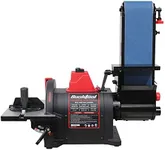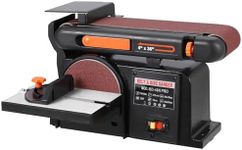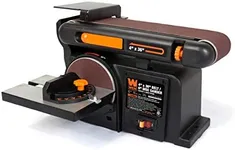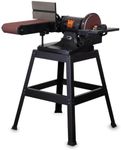Buying Guide for the Best Benchtop Sander
Choosing the right benchtop sander can make a significant difference in the quality and efficiency of your woodworking projects. A benchtop sander is a versatile tool that helps in smoothing, shaping, and finishing wood surfaces. To find the best fit for your needs, it's important to understand the key specifications and how they impact the performance and usability of the sander. Here are the main specs to consider when selecting a benchtop sander.Motor PowerMotor power, measured in amps or horsepower, determines the sander's ability to handle tough materials and prolonged use. Higher power motors (above 1 HP or 8 amps) are suitable for heavy-duty tasks and harder woods, while lower power motors (below 1 HP or 5-7 amps) are adequate for lighter, occasional use. Choose a motor power that matches the intensity and frequency of your sanding projects.
Belt SizeThe belt size refers to the dimensions of the sanding belt, typically measured in inches (width x length). Common sizes include 4x36 inches and 6x48 inches. Larger belts cover more surface area and are better for larger projects, while smaller belts offer more precision for detailed work. Consider the size of the projects you typically work on to determine the appropriate belt size.
Disc SizeDisc size indicates the diameter of the sanding disc, usually ranging from 6 to 12 inches. Larger discs provide a greater sanding surface and are ideal for bigger pieces of wood, while smaller discs are better for fine-tuning and detailed sanding. Match the disc size to the scale of your projects and the level of detail required.
SpeedSpeed, measured in revolutions per minute (RPM) for discs and feet per minute (FPM) for belts, affects how quickly material is removed. Variable speed options allow for greater control and versatility, enabling you to adjust the speed based on the material and desired finish. Higher speeds are suitable for rapid material removal, while lower speeds are better for fine finishing. Choose a sander with speed settings that align with your project needs.
Dust CollectionDust collection systems help keep your workspace clean and reduce airborne particles, which is important for both health and visibility. Some benchtop sanders come with built-in dust ports that can be connected to a vacuum or dust collection system. Look for a sander with an efficient dust collection feature to maintain a cleaner and safer working environment.
Table AdjustabilityTable adjustability refers to the ability to tilt or angle the worktable, which can be useful for sanding beveled edges or working on angled pieces. A table that can be adjusted to various angles (typically up to 45 degrees) offers more versatility in your projects. Consider how often you need to sand at different angles and choose a sander with the appropriate table adjustability.
Build QualityBuild quality encompasses the materials and construction of the sander, affecting its durability and stability. Look for sanders made with sturdy materials like cast iron or heavy-duty steel, which provide a stable base and reduce vibrations. A well-built sander will last longer and perform more reliably, so consider the overall construction quality when making your choice.

